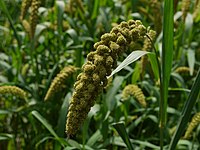
Harnessing wild relatives of pearl millet for germplasm enhancement: Challenges and opportunities
Sign Up to like & getrecommendations! Published in 2020 at "Crop Science"
DOI: 10.1002/csc2.20343
Abstract: Assigned to Associate Editor Hannes Dempewolf. Abstract Pearl millet [Pennisetum glaucum (L.) R. Br.] is one of the world’s hardiest warmseason cereal crop and is cultivated mainly in the semi-arid tropics of Asia and Africa… read more here.
Keywords: crop; germplasm; millet; improvement ... See more keywords

Geographical distribution of quinoa crop wild relatives in the Peruvian Andes: a participatory mapping initiative
Sign Up to like & getrecommendations! Published in 2020 at "Environment, Development and Sustainability"
DOI: 10.1007/s10668-020-00875-y
Abstract: The Peruvian Andes are among the world’s most important centers of origin for genetic diversity of crops and plants. Quinoa ( Chenopodium quinoa Willd.) was domesticated in the Bolivian and Peruvian Andean region around Lake… read more here.
Keywords: wild relatives; crop wild; quinoa crop; peruvian andes ... See more keywords

Crop wild relative conservation: Wild yams are not that wild
Sign Up to like & getrecommendations! Published in 2017 at "Biological Conservation"
DOI: 10.1016/j.biocon.2017.05.001
Abstract: Abstract Extension of land use has been the main way to increase agricultural production to date. Natural habitats have consequently decreased and became increasingly fragmented, putting high pressure on the wild relatives of main crops.… read more here.
Keywords: wild yam; conservation; wild relative; wild relatives ... See more keywords

Neglected treasures in the wild - legume wild relatives in food security and human health.
Sign Up to like & getrecommendations! Published in 2019 at "Current opinion in plant biology"
DOI: 10.1016/j.pbi.2019.04.004
Abstract: The legume family (Fabaceae) is the third-largest flowering family with over 18 000 species worldwide that are rich in proteins, oils, and nutrients. However, the production potential of legume-derived food cannot meet increasing global demand. Wild… read more here.
Keywords: legume wild; treasures wild; neglected treasures; wild relatives ... See more keywords

Why should we save the wild relatives of domesticated animals?
Sign Up to like & getrecommendations! Published in 2018 at "Oryx"
DOI: 10.1017/s0030605318000601
Abstract: In his opus on the pheasants of the world, published in the early s, the zoologist William Beebe wrote that his observations on wild red jungle fowl, the progenitor of domestic chickens, in the jungles… read more here.
Keywords: domesticated animals; relatives domesticated; domestic breeds; jungle fowl ... See more keywords
Proteolytic Activity in the Midgut of Helicoverpa armigera (Noctuidae: Lepidoptera) Larvae Fed on Wild Relatives of Chickpea, Cicer arietinum
Sign Up to like & getrecommendations! Published in 2018 at "Journal of Economic Entomology"
DOI: 10.1093/jee/toy160
Abstract: Abstract Wild relatives of crops are an important source of resistance genes against insect pests. However, it is important to identify the accessions of wild relatives with different mechanisms of resistance to broaden the basis… read more here.
Keywords: larvae fed; activity; armigera; resistance ... See more keywords

Grain Disarticulation in Wild Wheat and Barley
Sign Up to like & getrecommendations! Published in 2022 at "Plant and Cell Physiology"
DOI: 10.1093/pcp/pcac091
Abstract: Abstract Our industrial-scale crop monocultures, which are necessary to provide grain for large-scale food and feed production, are highly vulnerable to biotic and abiotic stresses. Crop wild relatives have adapted to harsh environmental conditions over… read more here.
Keywords: grain disarticulation; disarticulation; disarticulation wild; wild relatives ... See more keywords

A large set of 26 new reference transcriptomes dedicated to comparative population genomics in crops and wild relatives
Sign Up to like & getrecommendations! Published in 2017 at "Molecular Ecology Resources"
DOI: 10.1111/1755-0998.12587
Abstract: We produced a unique large data set of reference transcriptomes to obtain new knowledge about the evolution of plant genomes and crop domestication. For this purpose, we validated a RNA‐Seq data assembly protocol to perform… read more here.
Keywords: comparative population; reference; population genomics; wild relatives ... See more keywords

Domestication of tomato has reduced the attraction of herbivore natural enemies to pest‐damaged plants
Sign Up to like & getrecommendations! Published in 2018 at "Agricultural and Forest Entomology"
DOI: 10.1111/afe.12271
Abstract: Plant domestication can alter species interactions and influence novel associations among crops and insects. We performed a series of preference and performance experiments to test predator and herbivore attraction to domesticated and wild plants and… read more here.
Keywords: plant; domestication; tomato; wild relatives ... See more keywords

Capturing genetic variation in crop wild relatives: An evolutionary approach
Sign Up to like & getrecommendations! Published in 2018 at "Evolutionary Applications"
DOI: 10.1111/eva.12626
Abstract: Crop wild relatives (CWRs) offer novel genetic resources for crop improvement. To assist in the urgent need to collect and conserve CWR germplasm, we advance here the concept of an “evolutionary” approach. Central to this… read more here.
Keywords: variation; wild relatives; crop wild; approach ... See more keywords

Water stress resilient cereal crops: lessons from wild relatives.
Sign Up to like & getrecommendations! Published in 2022 at "Journal of integrative plant biology"
DOI: 10.1111/jipb.13222
Abstract: Cereal crops are significant contributors to global diets. As climate change disrupts weather patterns and wreaks havoc on crops, the need for generating stress resilient, high yielding varieties is more urgent than ever. One extremely… read more here.
Keywords: cereal crops; wild relatives; stress; water stress ... See more keywords